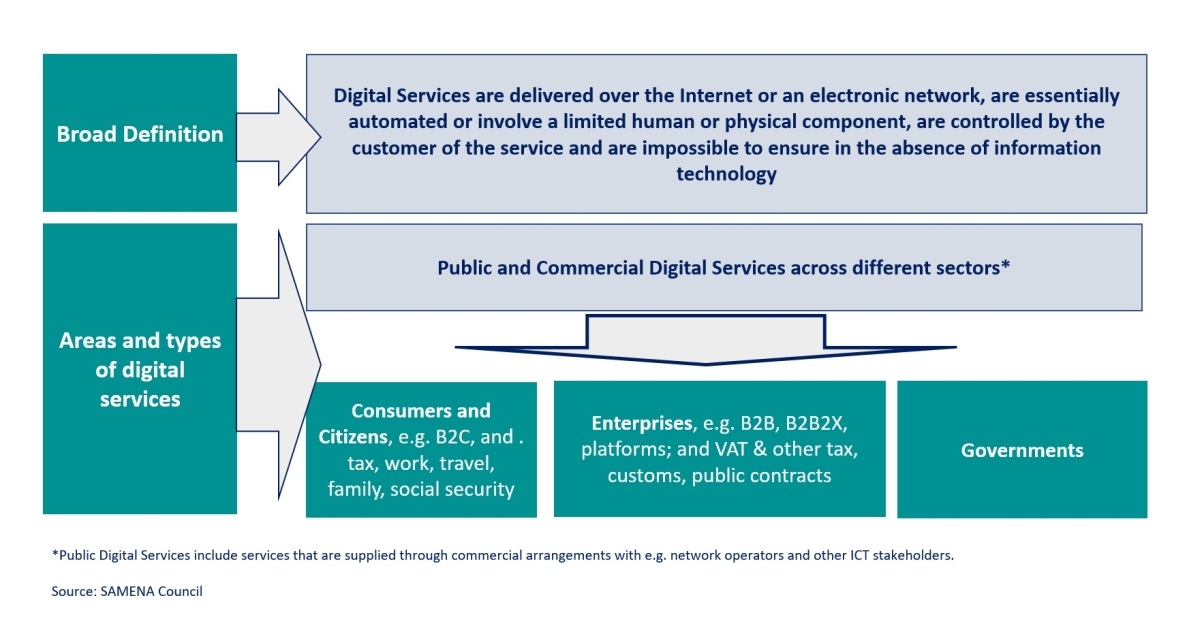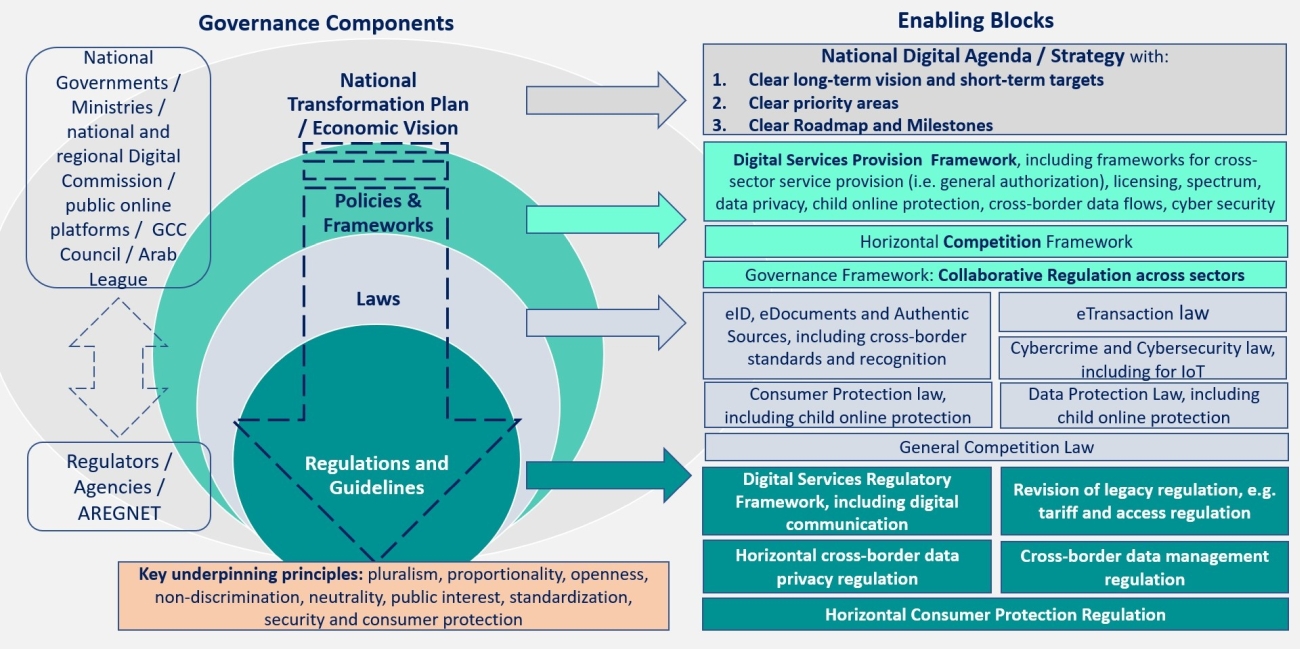Digital Services
SAMENA Council’s Generic Policy, Legal and Regulatory (“PLR”) Framework for Digital Services
For Consultation by SAMENA Council’s Members and Industry Stakeholders
Context
The SAMENA Council Working Group on Digital Services has developed a proposal of a high-level Policy, Legal, and Regulatory (“PLR”) framework for digital services to (1) provide an overview of key policy / regulatory enablers needed with the ultimate aim to achieve a level playing field for all ICT stakeholders to provide digital services, and (2) identify the best governance model, i.e. at what level, within what type of structure, and which body can drive, implement and monitor the proposals. Its main purpose is to serve in a contextual capacity to provide high-level guidance to governments and regulatory authorities across the SAMENA region (and beyond) in creating a thriving and supportive digital ecosystem that drives the development and emergence of innovative and meaningful digital services and can help push meaningful connectivity to 100%.

Digital Services Proliferation and Definition
A wide variety of digital services has proliferated globally across the public and the private sectors over the last 20 years. They span from public citizen services in, for example, the areas of travel assistance, work & retirement, tax, vehicles, residence formalities, education & youth, family, health and consumers, to public business services including VAT & customs and public contracts. There are commercial services to consumers, including communication services, video & entertainment, location-based or lifestyle services, mobile financial services, to name but a few; and there are enterprise services including information security, enterprise mobility management, unified communications, cloud services including storage, processing and analytics, services that are delivered through telco-industry partnerships and platforms to end-customers of other industry sectors (e.g. B2B2X), and many more. While digital services can constitute bespoke local solutions, their underlying deployment models can have global dimensions, where elements of the value chain can be spread across different countries and regions, as otherwise service provision in smaller, local markets can be uneconomical. An increased scope for digital services is emerging with the roll-out of 5G infrastructure, enabling enhanced greater speed broadband (to move more data), lower latency (to be more responsive), and the ability to connect a lot more devices at once (for sensors and smart devices (IoT).
Digital services can have many definitions, depending on the stakeholder perspective that is taken and therefore, there is not one agreed definition. However, based on various definitions available1, the core commonalities of digital services can be identified to include (a degree of or full) automation, delivery over the Internet or an electronic network, the use of information technology, and transfer of responsibility or control of service use away from the provider to the citizen or customer. In the context of the PLR framework, it is important to adopt a dynamic definition that is broad enough to capture the whole breadth of services available and flexible enough to allow future development and evolvement of services based on different and emerging technologies. The definition therefore needs to be forward looking and technology neutral and avoid hard distinctions based on current value chain positions of different ICT stakeholders. Figure 1 proposes a broad definition of digital services and sets out the different areas and types of services that have proliferated globally.
Figure 1: Definition and Overview of different types of Digital Services

1 See: Article 7 of the COUNCIL IMPLEMENTING REGULATION (EU) No 282/2011 of 15 March 2011 laying down implementing measures for Directive 2006/112/EC on the common system of value added tax, https://eur-lex.europa.eu/legal-content/EN/TXT/PDF/?uri=CELEX:32011R0282&from=EN ; EU GDPR definition of information service: https://eur-lex.europa.eu/legal-content/EN/TXT/HTML/?uri=CELEX:32015L1535; EU electronic communications service definition: https://eur-lex.europa.eu/summary/glossary/electronic_communications_services.html , Lea&Cox Associates definition: http://esmarchitecture.com/key-concepts/business-it-digital-services.html ; Cisco’s definition of a public digital service: https://www.cisco.com/assets/global/UK/public_sector/new/pdfs/DigitalPublicServicesWebSinglePageV1.pdf
Proposed PLR Framework for Digital Services
Governments as well as the industry have been quick to recognize the opportunity that digital services represent. For governments, digital services can help address local demand-side Internet adoption barriers such as capacity, relevance and affordability and can be an efficient conduit to contribute to achieving national transformation plans by tackling some of the most pressing urban and rural challenges. For the private sector, digital services can contribute to streamlining organization, operations and processes, as they are typically extremely cost effective with high levels of customer centricity. They can also provide an opportunity for network operators to diversify along the digital value chain and industry verticals and offer a broader set of new advanced digital services based on evolving technologies and network infrastructures, that lie outside traditional telecommunications services.
To ensure that innovative and meaningful digital services can flourish, a supportive digital ecosystem and enabling environment is needed that is based on the right policies, laws and regulations. The SAMENA Council Working Group on Digital Services is putting forward the following framework, that comprises key enabling blocks, governance components and indicative use cases, as set out in Figure 2.
Selected Use Cases
E-Government
Autonomous transport services
Remote health services
Industrial and vehicular automation
Mission-critical applications
IoT services (Smart home, smart cities, smart buildings)
Enhanced mobile broadband
5G-based fixed Wireless access

Recommendations to governments and regulatory authorities
SAMENA Council Working Group on Digital Services recommends that governments pursue comprehensive cross-sector and cross-stakeholder Digital Agendas, that may include the following:
1
Policies and Frameworks:
- Horizontal Digital Services Provision Framework, including frameworks for cross-sector service provision (i.e. general authorization), licensing, spectrum, data privacy, child online protection, cross-border data flows and cyber security and, introducing digital strategies for user-friendly government information and services
- Horizontal Competition Framework
- Governance Framework that is collaborative, cross-sector and cross-border, including identification, review, merging and assignment of responsibilities among different governmental-, ministerial- and regulatory entities across different sectors to monitor, evaluate and execute policies
2
Laws:
- The establishment of digital identification systems, including laws on eID, eDocuments and Authentic Sources, and cross-border standards and recognition
- eTransaction law
- Cybercrime and Cybersecurity law, including for IoT
- Data protection law, including for child online protection
- Consumer protection law, including for child online protection
- General Competition law
3
Regulations and Guidelines:
- Digital Services Regulatory Framework, including digital communications
- An enabling horizontal risk-based regulatory approach to the use and protection of data,
- An enabling regulatory approach to cross-border content and data flows, including horizontal cross-border data privacy- and data management regulation
- Horizontal consumer protection regulation
- Review and, where found unnecessary, removal of burdensome legacy regulation